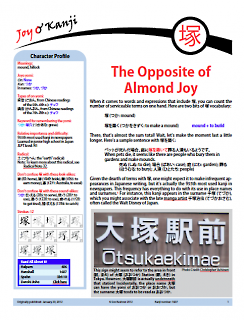塚
mound, hillock
Kanji 1607
Thank you for visiting this Character Home Page. Below you'll find a synopsis of the essay. If you wish to read the full text, the PDF of the essay is available for purchase to the right.
The mound kanji appears in very few words, but it's prevalent in Japan nonetheless, thanks to its role in surnames and place names. Mounds have also played a significant role in Japanese history, from burial mounds and memorial mounds to shell mounds. Unexpectedly, studying 塚 opens a fascinating window onto the Japanese past.
Revision history:
Feb. 9, 2024: p. 3: Reversed the order of names for Keiji Imamura.
May 31, 2021:
- p. 2: Updated the Henshall etymology.
- p. 5: Changed the definition of the 古墳 era.
- p. 7: Added a link to the Kanshudo games.
Aug. 3, 2012: When I created a version of the PDF on July 20, I used a lower setting than I meant to use. Now the images should be sharper.
July 20, 2012: In the sidebar on page 5, I had previously listed two ways of saying "memorial mound." However, my proofreader can confirm only one term with that meaning, so I've deleted the other.



Comments